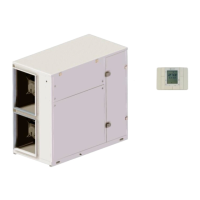11
5 - AERAULIC CONNECTIONS
The dimensioning and correct execution of the aeraulic
connections are fundamental to guarantee good unit operation
and adequate level of silence in the room.
When designing and manufacturing the channels, consider
LOAD LOSSES, AIR FLOW AND SPEED that must be
consistent with the unit features.
Particularly consider that load losses higher than the unit
useful prevalence, lead to reduction in flow rate, with
consequent unit blocks.
the weight of the channels must not burden on the
connection flanges
place anti-vibration joints between channels and unit
connection to the flanges and between the various
sections of the channels must guarantee air seal, avoiding
dispersions penalising the overall efficiency of the system
limit the load losses by optimising the path, the type and
number of bends and junctions
use wide bends evaluating the opportunity of equipping
them with deflectors (in particular with high air speed or
bends with reduced radius).
5.1 Generality
The internal surface of the channel must be smooth, enable
its washing and must not contaminate the air
Thermally isolate the channels and the flanges to avoid
energy losses and forming of condensation
DIFFUSERS INLETS GRILLES
A correct diffusion of the air in the room is determining for the
level of comfort.
When choosing and positioning the grilles, inlets and
diffusers, avoid:
excessive air speed
forming of stagnant and stratification areas
cold air delivery in room
forming of localised currents (also due to uneven
distribution of air)
excessive room temperature variations, vertically and
horizontally
short circuits of the supply air towards the return air.
For sound comfort, consider that :
the air diffusers must be chosen verifying the sound power
generated at nominal flow rate conditions
the cut-off to diffusers must be carried out with flexible
elements
the return grilles must be widely dimensioned.
5.2 Treated air channelling
Thermally isolate the channels and the flanges to avoid energy losses and forming of condensation

